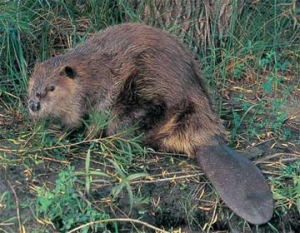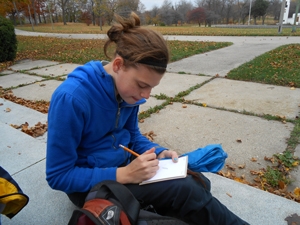
Earth Day of Service Is Right Around the Corner...
... and this year we (or rather, you) get to do it all; digging in dirt, helping with trail or rain garden maintenance, eating great food and discovering new things about the earth!
We've had a terrific Earth Month so far celebrating all the wonderful and important resources of our planet. Our Earth Month culminates with a city-wide, all-hands on deck Earth Day of Service, a time to give back, pitch in, and show the world a little love on Saturday, April 25. Come join us!
Native Animal of the Month: Beaver (Castor canadensis)
I have a confession. A part of me enjoyed when the Riverside Park beaver was a secret. I liked sneaking through the park examining tree trunks along the river for signs of beaver chewing. I enjoyed watching the progress of the chew on the large cottonwood that first revealed signs of the beaver. I enjoyed sharing the location of the tree with nature-loving volunteers and I entertained myself by photographing two of those volunteers with the last name "Beaver" kneeling next to the tree pretending to gnaw at the bark.
Not Just A Rock
The morning sunlight shimmered on the rippling surface of the river. It was a beautiful day in late fall as second graders hiked along the Menomonee Valley trails. The excitement of the kids grew as the trail got more and more covered by the trees. I realized that the border between them and the natural world had started to break down when I heard a few “wows” for a Blue Heron that flew by and a salmon going up the river to spawn. You could sense the connection one student had as she held an improvised walking stick.
From Fear to Understanding
I love fall! We begin a new school year with excited students, perfect sunny days and beautiful changing leaves. Fall is also when I get to teach a class that brings kids into the water to look for macroinvertebrates. It’s one of my favorite classes to teach.
The program begins with the students tucking in their shirts and climbing into waders to explore the Milwaukee River. We hand them kick nets and bins to hold the benthic invertebrates they find. As we head to the river, there is nervous excitement. It is fun to watch the first groups get their bearings in the water.
Appreciating Wild Spaces
I am writing this article on my way back to Milwaukee after an incredible trip to Alaska. Willie Karidis, with lighthearted expertise, gave the Urban Ecology Center eco-travel group a wonderful experience of wilderness. We witnessed Denali, the tallest mountain on the continent, rise out of brilliant reds and yellows of Alaska autumn. We marveled at moose and wandered among wolf tracks. We splashed through icy rivers and padded across spongy tundra. It was a trip filled with awe for vast expanses of beauty that stretched as far as we could see and amazement at remarkable minutia close enough to touch. Willie called it “Subarctic splendor.”
But this article is not about the Alaskan wilderness.
Driven to Discover
This summer and fall, bring your inquisitive 8 – 12 year olds to Driven to Discover: Outdoor Inquiry Camp at Riverside Park. This 10-week program guides kids through the process of discovering answers to their own questions while being active outdoors.
Baby Parks and Plantings
In the spring of each year, all sorts of adorable baby animals can be seen. This spring, I saw baby Great Horned Owls (called owlets), baby White-footed Mice (called pups, pinkies or kittens) and baby Brown Snakes (called snakelets or hatchlings). We don’t usually pay close attention to “baby” plants, but they’re showing up now too!
A School Year of Firsts
“Miss Katie, I love nature!” “Nature is the best!” I absolutely love hearing these exclamations as students dance on Washington Park’s Band Shell, climb fallen trees or dip nets into the lagoon. As my first year of teaching students in our school program comes to an end, I begin to reflect on everything I have learned during this year.
Violets - An Uncommonly Delicious Treat
Every spring I get excited about the start of the growing season. You may think that my name being Matt Flower drives this next statement, but really, I treat it as a family reunion. Each week old friends come back to visit — either nesting in the same woods, growing in the same spot, slithering by the same log or fluttering in the same area. One of my favorites friends of spring are the common violets — a small purple flower of the forest, field and lawn. Despite its common appearance and stature, the common violets is a giant among edibles. Packing as much vitamin C as a whole orange and the leaves are one of two wild plants topping the vitamin A charts, this flower makes a great edible.
Build It!
“Get out your hard hat! It’s time to put some materials to the test. Stretch’em, soak’em, crush’em – use what you learned to construct something (a bridge, a bird nest or a building) to solve a problem.”
This is the description for one of our school programs for second graders. We use the Three Little Pigs story as a reference. Students get to know about the properties of certain materials, then they are divided into groups to build up sturdy enough structures out of cups so as to withstand the wolves’ huffs and puffs.
Copyright © 2023 The Urban Ecology Center












